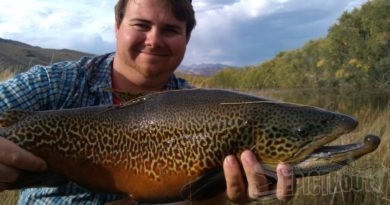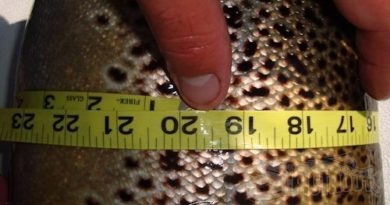Going Green
Here is the situation that I am in. I have a beautiful 18 foot Alumaweld boat that has three motors (two gas and one electric), four eletric downriggers and two top of the line fish finders. So what am I doing in a 12 foot folding boat with an electric motor? Am I trying to save the world by going green? No, not really. It’s more like I am trying to save my back! I will explain later. Over the years I have had a few boats and each boat has served a specific purpose. I fish out of a larger boat 90% of the time but there are a few situations where my 18 foot boat is just not practical. I fish year round in Northern Nevada and Northern California and there are times when all the boat ramps are full of snow but the lake is fishable and ice free. During spring and fall, the lake levels fluctuate which tends to make the shoreline a muddy mess and raises the stakes of getting stuck when launching a trailered boat. There are also times when I tow the family camp trailer to the lake and I don’t have another vehicle to pull up my larger boat.
It all started after fishing with my friend, Mark Wiza, in his crazy folding boat. This spurred my interest in finding a solution to my dilemma that I often found myself in with my Alumaweld. After researching on the Internet for hours, I was down to two finalists; a Zodiac or a Porta Bote. Why its spelled “bote” and not “boat” I will never know. Maybe it adds to the mystique of being a folding boat. I picked the Porta Bote over the Zodiac for a few reasons. First, the Porta Bote has a smooth “V” shaped hull that limits water drag allowing it to go faster and use less energy. Second, the hull folds up 6 inches thick and its very light. I even made custom mounts that fasten on the side of my camp trailer so I can store the Porta Bote there year round when its not in use.
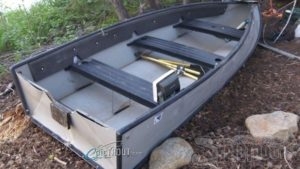
Unfortunately, there were times when I was disappointed with my little folding and I knew that I needed to iron out the wrinkles in order for it to be an effective tool. For starters, the Porta Bote needed adequate rod holders that could handle a heavy loaded rod. Since the boat is made out of extremely flexible plastic, I didn’t want to drill or permanently mount anything to the side of the gunnel. I have electric downriggers on my Alumaweld and the thought of trying to mount an electric downrigger on the Porta Bote was a little over whelming. One afternoon I was sharing my concerns with my life long friend, Scott C. Scott is one of those guys who can design, build or repair just about anything made out of metal. The next day Scott showed up at my house with a custom metal job that firmly mounts to the oar holders and straps to the center seat. Thanks buddy!
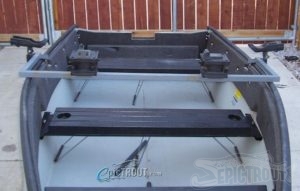
I found a clamp-on bracket for my transducer and then mounted one of my extra 10.4″ sonar screens to the bench seat. By swiveling the sonar screen, the passenger in the front seat can easily see what is going on below the boat. Great, another problem solved!
My biggest obstacle was finding a reliable power plant. I have four gas powered outboard motors built anywhere from 1975 to 2000. One is a four horsepower motor that only pushes the boat around 6 mph and sounds like a weed wacker and loud enough to scare away any trout that are near my boat. Another motor is an eight horsepower Mercury which has a habit of overheating if it idols for any length of time even though it has a new impeller. I also have a 1984 fifteen horsepower Mercury that runs like a bat out of hell; when I can get it started. It also weighs 88 pounds. Truth is, all three motors are hard to get started, but once they do, they usually run well at home while in the test tank. Getting them out on the lake is a different story. It seems like they are temperamental and act up when submerged in 34 to 40 degree water temperatures. I’ve had my share of endless tugs and yanks on that stupid starting rope to leave my poor body twisted and torn. I’m sure you are familiar with the phrase, ” a mind is a terrible thing to waste,” well so is your back! Starting an old, cold motor in the early morning with the air temperatures below freezing can be a brutal work out. My fourth motor is a four stroke Honda that runs great and starts easy, but its a long shaft motor and definitely more suitable for my bigger boat. The thought of buying a new 9.9 horsepower four stroke motor is hard for me to justify for a Porta Bote that I’m only going to use a few times a year
Over the years I have been blessed to ProStaff for several awesome companies. One of the companies that I currently ProStaff for is Minn Kota. They are the leader in electric outboard motors. I did some more research and found a motor that would fit my needs. I was looking for a transom mount motor that had variable thrust adjustments. Minn Kota makes a 12, 24, and 36 volt motor that range from 30 to 101 pounds of thrust. I wanted my motor to run off of one 12 volt battery. I decided to go with the Minn Kota Endurance Max 55 which weighs in at 21 pounds and boasts 55 pounds of thrust. I like the 12 volt system because it allows me to have one battery for the motor and an extra battery in the front to balance out the boat. The extra battery also powers the electronics (sonar, GPS, and electric down riggers). I also swap the batteries when the motor battery gets low.
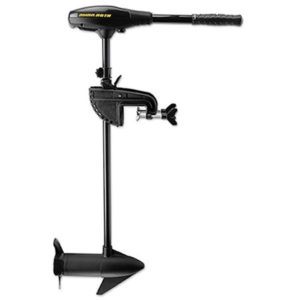

The Minn Kota Endurance Max 55 works fantastic on the Porta Bote. With two people in the boat the top speed is 4.1 miles per hour at 100% power but pulls a whopping 50 to 55 amps. One time under some extreme wind conditions the motor tripped a 50 amp circuit breaker. I replaced it with a resettable 55 amp circuit breaker and it has held up well under the same conditions. The Minn Kota Endurance Max 55 has a maximizer feature that offers two unique benefits. The first is infinite variable speed control. The second is more run time on a battery charge versus a five speed control motor. The Maximizer is an electrical switch that turns the connection to the battery on and off 20,000 times per second. Regardless of the power setting, the transfer of power is consistent and smooth. With the thrust set at 100 %, the switch is on all of the time allowing for the max draw. As the thrust is turned down, the electrical switch turns off for longer intervals . The overall motor is very efficient and basically no current is wasted.


The life expectancy of a battery depends on what power setting or speed you run your boat and the size of the battery. Lets start with the battery. I recommend that you have a 100 amp hour battery or better. The 100 amp hour rated battery is capable of delivering a total of 100 amp hours of power on a single charge. This could either be 100 amps delivered for one hour, or 25 amps delivered for four hours or 10 amps for ten hours. The Minn Kota Endurance Max 55 draws around 50 amps at top speed. With this formula we would be looking at two hours of fishing at 4.1 mph. By using an amperage multimeter I found that the motor pulls roughly 30 amps when I’m trolling at 3 mph so that calculates to over three hours per battery at this speed. The big change was 1.2 mph my flatfish speed. The draw was only 8 amps giving me a amazing 12+ hours of fishing on one battery. To be honest, if this was my only boat, I would spend the money on a small gas power motor as a power plant. However, since I only fish out of my Porta Bote during 10% of my trips, all I need to do is pull the batteries out of my big boat. It’s a perfect fit for my situation.
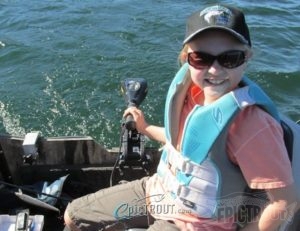
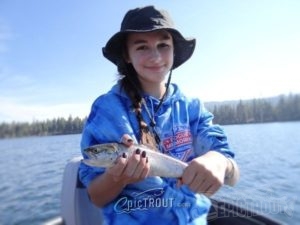
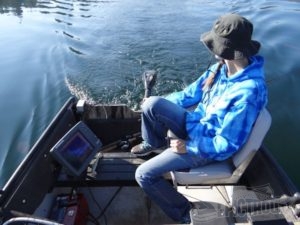
This little underpowered folding boat has been a fun change of pace from fishing in my larger boats. I feel so connected with my surroundings when fishing so close to the surface of the water with a rear tiller boat. My kids also love fishing from the boat. The boat is so easy to control that they can steer the boat when trolling and I just relax in the front seat and enjoy the scenery. The coolest thing happened on my last fishing trip with Katie, my oldest daughter. I was sitting in the front of the boat without a rod in the water as Katie controlled the boat. I watched her in amazement as she proceeded to catch and release a dozen or so trout while vertical jigging. She was in total control and doing everything by herself. Katie found the fish on the sonar, stopped the boat, dropped the jig in the water, and hooked the fish all by herself. I didn’t do a thing. As I sat there in amazement, Katie said, “Hey dad, how about I put you on some fish.” All choked up, I replied “sure.” Katie, with her eyes glued to the sonar, parked the boat over a suspended trout and said, “Alright drop your jig in the water and I will tell you when to stop.” I must admit in all of my years of jigging this was a first for me. I have jigged out of other people’s boats before and I would stare at the sonar and process what was going on down below without receiving any help from anyone else so when Katie said to me, “Get ready to …… STOP!” my reaction to her command was a few seconds slow as I fumbled to process what she just said to me. Then she said, “Ok, you are just below the fish so reel in three cranks and you will be right on it.” I actually felt a little nervous but I did what I was instructed. Bam! “Fish on,” I shouted. This fish was no where close to being the biggest fish that I caught this year, but it will be the one fish that I will never forget because my daughter guided me to catch it. It was truly awesome! The porta boat is worth it’s weight in gold.

Porta Bote Piggy
Pros:
Starts immediately. There is no yanking on a rope and no warm up time. Just turn the handle and you are fishing.
Extremely lightweight. The motor weighs 20 pounds. Launching in extreme conditions are hassle free. The boat itself only weighs 89 pounds. If you are able to park close and walk to the lake, then you can launch.
Odor free. There is no smelly gas or exhaust fumes.
Stealth. The fish never even know you are there. With this boat and motor, I can troll extremely shallow without spooking fish. I have snuck up on trout while feeding on a school of chub close to the surface and I literally tossed a lure to them.
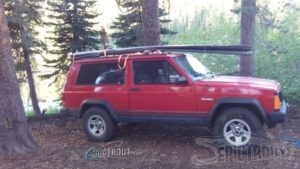
Cons:
Slow. You have three speeds. Slow, slower and slowest. You loose the ability to travel all over the lake to find fish. You pretty much want to fish within 5 miles from your launch point. Top speed with two people in the boat and all their gear is 4.1 mph.
Battery power. With this system you have a limited amount of power per battery. The faster you go, the faster you will run through a battery. I carry two batteries on the boat. One battery for the motor and another for the sonar and electric down riggers. I swap the batteries when the trolling battery gets low. I also keep two extra batteries in the truck or at the campsite as back-ups. When fishing at higher speeds or for longer hours, I have had to use all four batteries.
I now own an environmentally friendly , renewable powered boat and motor. In other words, I now own a tiny under-powered slow boat that you wouldn’t want your friends to see you in ………but it fishes really well and my back doesn’t hurt, which is what really matters!
Brad Stout


